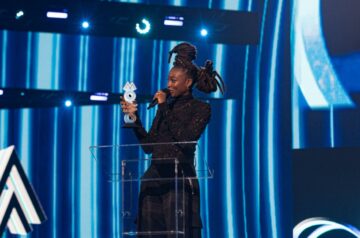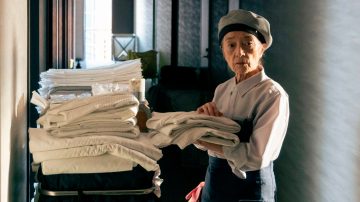
★☆☆☆☆
Read our review of Vol.1 here.
The second volume begins with footage of the late Queen’s marriage. Her and Phillip’s stoic stature stand to attention as guards of themselves into posterity. A commentator is heard: “Elizabeth and Phillip take their places on history’s pages”. The old film is blurred and grainy, a relic of a simpler time as we perceive it. Despite, or perhaps because of, the low-definition images, they tell a clear story.
When we cut to Meghan and Harry, they are shot in the high definition to which we have become accustomed. Their story is well-lit and stage-managed – we can zoom into the granular level and see every pixel. And yet its message and meaning are far more oblique. The more clarity they give, the more confusing it gets.
From their California mansion, the couple recounts the events of their wedding. Their pieces to camera are interspersed by footage of town criers, yeomanry, and well-wishers who marked the occasion. Harry and Meghan, or H and M as they refer to one another, light up when they tell how thoroughly they were accommodated.
There was no objection to Meghan’s suggestion that a gospel choir perform at the wedding ceremony – to the contrary, the Royal Family poached the world’s best singers to form the Kingdom Choir. Prince Charles dutifully walked Meghan down the aisle in the wake of her estrangement from her own father. Jubilant crowds lined the streets as she was transported to George’s Chapel. This, though, as the telling goes, is the calm before the storm.

The couple describe their life in Nottingham Cottage – and are keen to tell us that although it was on palace grounds, it was not a palace. The attempt to paint a picture of a humble abode raises an early eyebrow as Meghan, half-jokingly, complains of how Harry would bang his head on the low ceilings. Life carries on well, with Meghan joining the late Queen on royal engagements and continuing to enjoy a warm reception from the British public.
This harmonious existence is cut short by what the pair see as the inciting incident of their heroic journey – their Australia trip. You see, Meghan was just too popular, far more popular than Kate Middleton, then the Duchess of Cambridge. This sparked animosity, grudge and grievance and paved the way, they assert, for a spate of negative media stories. The claim is congruent with Harry’s assertion in the first volume that his family were “intimidated” by his partner’s beauty and intelligence.
The documentary makes ample use of headlines and other media snippets to support its narrative. As the pair indulge their fantasy, a Daily Beast headline is sprawled across the screen: ‘Meghan Markle and Prince Harry are wildly popular. That could be a problem.’ I dived into the article and found that the Daily Beast, a Left-wing American outlet, criticised Meghan for breaching royal protocol. It reported that “the couple clearly goofed by announcing their pregnancy to close family and friends at, or very shortly before, Princess Eugenie’s wedding”. If the American Left thinks your breach of royal protocol is a “goof”, it might be worth taking note.
By and large, the Daily Beast article does not say what the documentary implies. This was the case with several articles produced in support of its narrative. On another occasion, the former Duchess complained of reporting that linked a mosque she had connections to with terrorists. A Daily Mirror headline, again a Left-wing paper, is splashed onscreen. It reads, ‘Kitchen backed by Meghan Markle’s cookbook is in mosque ‘linked to 19 terror suspects’’.
I looked into the article, and the reporting appears to be entirely factual, as the Mirror reports: “Three of the four “Beatles” terror suspects – Choukri Ellekhlifi, Alexanda Kotey and Aine Davis – are believed to have attended the mosque.” The article continues to editorialise in Meghan’s favour, accurately recording that “these attitudes are at odds with what the Duchess has campaigned for in the past. She has been praised for her feminist values and has supported charities that empower women.” No doubt there are hundreds of unfair stories about H and M, but the inclusion of these is either pure laziness by the producers or an attempt to weave a deceitful and threadbare narrative using cherry-picked pieces of evidence.

On another occasion, a great deal of fuss is kicked up about a Daily Express article criticising Meghan for eating avocados. ‘Meghan Markle’s beloved avocado linked to human rights abuse and drought, millennial shame’ is self-evidently a ludicrous article, but its importance is played up. The article, published in 2019, only has two comments – both from 2021 – suggesting that nobody would have ever heard of this third-rate piece of journalism if not for the couple’s constant amplification.
What’s more, the documentary uses the same disingenuous tactics it and its subjects decry – Harry is even some kind of disinformation Tsar now, by the way. The film cuts away to Afua Hirsch pontificating about the future of the Royal Family. She explains that it could be inclusive or reinforce historical injustices. Overlayed is a zoomed-in picture of William and Kate meeting Jamaican well-wishers in Kingston through a chain link fence. In a vacuum of context, the photograph looks wicked and colonial.
The casting of racist aspersions onto Will and Kate is only possible by extraditing some essential information – they were inside a football ground. Nobody complained when Raheem Sterling did the same thing. The film totally lost my trust when it employed Kehinde Andrews to slate Britain as racist. The author, who says that ‘whiteness’ is a form of psychosis, claimed that using the word “diva” was a racist anti-black dog whistle. ‘Rules for thee and not for me’ spring to mind.

Harry and Meghan complain of Twitter trolls and intrusive paparazzi. That’s a legitimate but not exceptional complaint. These are the costs of celebrity, the price of living in a gilded cage. I sympathise wholeheartedly with the couple, though choosing to make this documentary, one amongst a litany of public projects, flies in the face of their declared wish for a quiet life.
It struck me that both Harry and Meghan come across as permanently anxious. They seem like troubled individuals who have found one another as a port in the storm. From there, they have forged an ‘us against the world’ narrative; they are the forces of good against an evil world.
You only have to hear one of Harry’s disinformation speeches or see one of Meghan’s NGO missions on vaccine equity to see how shallow and two-dimensional their view of the world is. The video diaries and selfies they produce to pad out the egregiously long programme are mind-numbingly juvenile and self-absorbed. That they call one another ‘H’ and ‘M’ is like something out of a John Green young adult fiction novel.
Frankly, they just don’t seem like individuals equipped to handle the roles with which they were entrusted. And that’s fine, but let this be the last chapter in their tedious public saga.




1 Comment
After reading this succinct review I feel inclined to cancel my Netflix subscription!